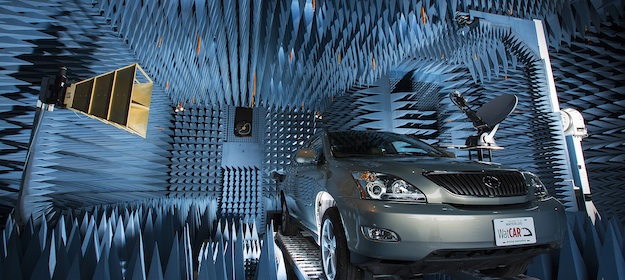
Open to Business
By Mike McLeod
General Canadian Light Source slideshow University of Ontario Institute of Technology University of Toronto University of WaterlooCanadian university research facilities embrace SMEs for commercial R&D projects.

Available to rent on an hourly basis, the climactic wind tunnel at UOIT’s Automotive Centre of Excellence generates wind speeds beyond 240 kph and temperatures down to -40°C.
And in many parts of the world, that may be true. But at Canadian universities, and the cutting edge engineering research facilities they house, public/private ventures are not only welcome but core to their mandate. According to Dr. Ted Sargent, vice-dean of research for the faculty of applied science and engineering at the University of Toronto, the era of defined lines between purely academic and commercially-oriented research have blurred.
“To the extent that there has ever been a perception that universities can be a bit “ivory tower,” I feel that, within the faculty of engineering, we are moving away from any such perception,” Sargent says. “As engineering researchers, we know our friends in industry have their finger on the pulse of what society wants and needs. And of course we have a great deal to offer in terms of advanced technologies and capabilities. So we feel it’s really core to our mission to partner with industry.”
Wind Tunnel
Increasingly, Dr. Sargent sentiments are being echoed at Canada’s leading engineering research universities. Nowhere is that more evident than at the University of Ontario Institute of Technology’s (UOIT) Automotive Centre of Excellence (ACE) in Oshawa. Best known for its climactic wind tunnel—that can generate wind speeds beyond 240 kph, temperatures from -40 to +60°C and relative humidity ranges from 5 to 95 per cent—the one-of-a-kind facility also offers a number of smaller chambers designed for structural durability and lifecycle testing.
The most striking thing about ACE, however, may be that it’s run as much like a business as an academic facility. While owned by the university, ACE emphasizes that it is fully independent, available for rent on an hourly basis and has served customers as far ranging as small sports equipment makers to Hollywood-style film productions. In fact, says John Komar, director for engineering and operations at ACE, approximately 90 percent of the facility’s time since it opened in 2011 has been taken by commercial ventures.
“Automotive is a good portion of our business but we also cater to aerospace, architectural, consumer products, defense, energy development, athletics and other human factors as well as media production,” he says.
ACE’s real value, Komar adds, lies in the facility’s close tie-in with the university. For smaller and less research-savvy start-ups and SMEs, having world-class academic researchers on hand can prove invaluable.
“All our clients like the fact that they can validate their products using a $100 million tool that’s independent, highly secure and operated by team of top notch engineers and technicians,” Komar says. “We are all about getting the science off the bookshelf and into proof of concept and proof of concept to market.”
Anechoic Chamber

The University of Waterloo’s CIARS lab houses one of the world’s most sensitive anechoic chambers, capable of measuring a broad spectrum of near-field and far-field radio wave frequencies and transmission types.
“We don’t engage in research here unless we have an industry partner,” says Ross McKenzie, managing director of the Waterloo Centre for Automotive Research (WATCAR) at the University of Waterloo. “And, in many instances, we are the lab for hire, but ultimately we exist to educate and train. We are more of a medium- to long-term option for industry.”
To help foster commercial partnerships, the University of Waterloo opened the Centre for Intelligent Antenna and Radio Systems (CIARS) lab last year. Like the UOIT wind tunnel, CIARS’ anechoic chamber is unparalleled. According to McKenzie, it is the only publicly available facility in the world that can generate and measure a broad spectrum of near-field radio wave frequencies and transmission types (e.g. planar, spherical and conical). It’s also the only wireless research lab that can simulate far-field transmission as well.
Antennas may seem a niche field, but McKenzie points out that, as the Internet of Things concept takes hold and more radio frequencies become available, nearly every electronic device, from household appliances to McKenzie’s own automotive focus, will incorporate antennas to broadcast and receive cellular, Wi-Fi, GPS and/or Bluetooth signals.
“To give an automotive example, in the next 10 years, the car will become its own hotspot with a unique IP address,” he says. “Antenna manufacturers, whose products provide that connectivity, will need to make sure the new spectrum and bandwidth out there doesn’t cause interference with its antennas. So even existing products will need to be tested and validated.”
In addition to the CIARS lab, McKenzie says the University of Waterloo is unique in the way it handles intellectual property agreements. At most North American universities, he says, the first thing that follows a research proposal is the signing of a non-disclosure and research contract between the industry partner, the research team and the university.
“Any intellectual property that comes out of that project is shared by all three parties,” he says. “At Waterloo, however, the university doesn’t seek to retain ownership of any resulting IP. That simplifies the conversation from the start since there are only two parties.”
Particle Accelerator

The only facility of its kind open to industry, the Canadian Light Source synchrotron at the University of Saskatchewan allows researchers to observe matter down to the atomic level.
And nearly anywhere else in the world and you’d be right. Not so in Canada, says Jeff Cutler, deputy director of the Canadian Light Source (CLS) in Saskatoon. In fact, CLS is the only such facility in North America and one of handful in the world open to commercial research.
“One of the things we have tried to do is make this facility more available to SMEs,” says Cutler, who also serves as the CLS director of industrial science. “In other places in the world, you would have to be a Boeing or 3M and have huge research programs and lots of money to spend, whereas we see that a lot of innovation comes out of small companies with 40 people.”
Opened in 2004 on the University of Saskatchewan campus, CLS is a 2.9 GeV high-energy synchrotron that uses electromagnets to accelerate a particle beam around a toroid-shaped vacuum tube. As the electrons approach the speed of light, they give off photons that can be focused and separated into its component wavelengths, from infra-red to high-energy x-rays. Those wavelengths are then tightly focused into beamlines that researchers can use to observe matter down to the atomic level.
According to Cutler, the spectrographic data collected can be used for a wide range of applications including advanced material science, nanotechnology, pharmaceutical development and the detection of environmental pollutants. But while CLS presents a unique research opportunity for Canadian SMEs, the challenge Cutler says is that many don’t know how or if it could help further their R&D efforts.
“That’s a problem for large multinationals as well,” he says. “Historically, the issue for a company looking at a synchrotron was that they would also need expertise in how to use it. What we’re saying to SMEs is, you are the expert in your problem, we are the experts in the tools. So they explain what they want to understand and we point them toward the right tool, help them do the experiments and then make sense of the results.”
Super Computer

With nearly 33,000 processor cores, the Blue Gene/Q at the University of Toronto is the fastest super computer in Canada.
Operated by the Southern Ontario Smart Computing Innovation Platform (SOSCIP), a consortium of seven universities including UofT and Western University, the Blue Gene/Q contains nearly 33,000 water-cooled processor cores, making it the fastest super computer in Canada and among the top 100 “Big Iron” machines in the world.
As impressive and potentially overkill as that sounds, most of the private enterprises that make use of the Blue Gene/Q fall into the SMEs category, says Laura Philippe, research communications manager with SOSCIP.
“All of our projects fall under five focus areas: Health, energy, cities, water and agile computing,” she explains. “Some of the companies we deal with already have a relationship with an academic researcher. But if a company had an idea for research in one of those areas but didn’t have an academic partner, they can still apply and we’ll help them find someone.”
Since the super computer officially came online in 2012 at the UofT’s SciNet HPC facility, Philippe says it has run big data projects in all its focus areas, but the facility hasn’t yet reached full capacity. And, once a project is approved by SOSCIP’s advisory committee, the super computer’s resources come at essentially no up front costs.
“SOSCIP donates the resources so, other than the manpower costs, there is no other money expected from commercial partners,” she says. “We also work in the background with partners on IP agreements and those kinds of issues.”
While it’s easy to focus on eye-catching, cutting-edge facilities, Canadian universities offer many other specialized engineering research labs and faculty expertise. For example, in addition to the Blue Gene/Q, UofT is home to the Centre for Advanced Nanotechnology and the University of Toronto Institute of Aerospace Studies (UTIAS).
However, combing through all the available opportunities can become a research project in itself. For those companies looking to form relationships with academic researchers, a good place to start is with organizations like the Ontario Centres of Excellence (OCE). Among its other directives, the non-profit organization specializes in brokering partnerships between academia and industry.
Comparable organizations to OCE across Canada (e.g. British Columbia Innovation Council (BCIC); Alberta Innovates; and Innovacorp in Halifax, to name only a few) keep close tabs on the research opportunities at the universities in their respective provinces. As such, they can play matchmaker between academic experts and promising Canadian companies looking to take their R&D to the next level. In many cases, they can also help explore the various financial options, whether through research grants, government-sponsored programs or splitting costs with the university itself.
ace.uoit.ca
ciars.uwaterloo.ca
www.lightsource.ca
soscip.org
